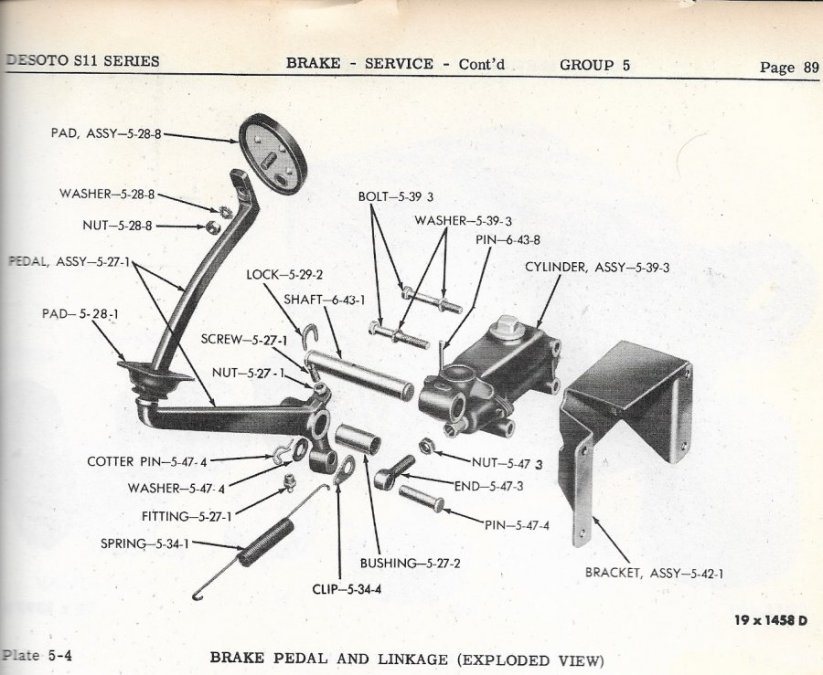-
Posts
1,860 -
Joined
-
Last visited
-
Days Won
10
Content Type
Links Directory
Profiles
Articles
Forums
Downloads
Store
Gallery
Blogs
Events
Everything posted by MarcDeSoto
-

M5 Fluid Drive - coupling capacity and observations
MarcDeSoto replied to 48 New Yorker's topic in P15-D24 Forum
What is the oil used for in modern usage? Is it a transmission oil? I wonder if auto garages carry it?- 11 replies
-
- fill
- fluid coupling
-
(and 3 more)
Tagged with:
-

M5 Fluid Drive - coupling capacity and observations
MarcDeSoto replied to 48 New Yorker's topic in P15-D24 Forum
Thanks for this info. I am going to be refilling my 48 DeSoto fluid drive soon also. Somewhere in the past I heard you could use automatic transmission fluid. Looks like it's available by the quart and gallon too. https://www.ebay.com/itm/Mobil-DTE24-Light-Hydraulic-oil-1-Gallon-128-oz/302112065835?hash=item465748492b:g:IqsAAOSw1KxXMhcu- 11 replies
-
- fill
- fluid coupling
-
(and 3 more)
Tagged with:
-

1947 Chrysler - Do I have to remove lock cylinder?
MarcDeSoto replied to ebruns1's topic in P15-D24 Forum
Mr. Tech talks a lot about locks in this filmstrip and booklet, but it's a deck lid lock. But there may be similarities between that and a door lock. He starts talking about locks at 9:37. http://www.mymopar.com/index.php?pid=378 -
Also, here is a guy on Ebay parting out a 50 Chrysler. https://www.ebay.com/itm/1950-Chrysler-Windsor-Fluid-drive-lug-nut-drive-shaft-sun-visor-PART-OUT/163740997078?hash=item261fb955d6:g:mmsAAOSwUSBdCP9R
-
I don't think finding another fluid drive unit will be that hard. Just put out an ad for one. I myself have a Dodge fluid drive from a 48 Dodge, but it's been sitting out in my backyard for 20 years. Surface rust. You might want to give Bernbaum a call. As he says on his website: Bernbaum’s now offers on-line buying. But never hesitate to call us if you need help! 800-457-1250 or 617-244-1118 from 9am - 5:30 pm Eastern time.
-
Boy, I love those pics! If the guys who made the movie Cars didn't have this one as a character, they really missed the boat! But there seems to be a non-factory item in the first pic. It looks like some kind of quadruped and it's on what we call in auto tech talk, the cat walk. Don't mess with the Plymouth 3 speed trans in this. All DeSotos have the Tip-Toe Shift transmission that came in the Chrysler, Dodge, and DeSoto cars. I thought I saw that you already have the M-6 trans?
-
I used to drive a 1950 Plymouth in the 80s with 4.1 differential and I can confirm that at 55 on the freeway, the engine was just screaming out for a 4th gear. The 46-48 Chrysler sixes had the 3.55 diff. and my 1948 DeSoto has a 3.73 diff. I don't know why the difference between a Chrysler six and DeSoto, but in 1949 Chrysler changed to 3.73. but 4.1 is just to low speed a rear end. Did all Dodges 46-48 have 4.11 diffs.? Where did you get the 3.55 diff?
-
I know it's your car and you make the decisions, and I know there are lot of guys on here that are for doing anything and everything to modify these old cars, but I would like to put in my two cents for keeping it original with 6 volts. And I also like the original oil bath air cleaner, even though there are many here who prefer to update that to a paper filter. Sometimes I don't know why the guys who want everything to be modern don't just buy a Dodge Demon or a Plymouth Duster, rather than a 48. I don't mind putting on modern radial tires and modern paint and all that, but just prefer to keep the other things historically correct. It will mean your wiring harness will cost more if you get the correct cloth covered type, but you can keep your original gauges, and radio, clock, etc. You did a very nice job polishing that up. Congrats on getting a great car! Plymouth Builds Great Cars!
-
There was a guy here that just got new U-joints from Bernbaum's.
-
This a little late, but for those who are going to do this gas tank job soon I recommend viewing this video. The gas tank demo starts at about 1:40.
-
Are you sure you have the 3 speed manual transmission? Almost all Dodges got the semi-automatic, or Gyromatic, transmission by 1949, except the shorter wheelbase Dodge Wayfarers, which continued with the 1948 type setup of fluid drive with 3 speed manual.
-
If it's really a 52 Dodge, that Hemi is from a different car. Dodge didn't get a Hemi until 1953. If the trans. is from a 53, I think it would be Fluid-Torque Drive. That's the one where an oil change takes 10 to 12 quarts I think. The same oil is shared by the engine and trans.!
-

48' Ply Coupe - concerned about parts availability
MarcDeSoto replied to Mountain Mopar's topic in P15-D24 Forum
Also, you can scan the WPC club newsletter, Hemmings, etc. for ads saying parting out 41-52 Plymouths, Dodge, Chryslers, and DeSoto. -
How's the chrome on that "harmonica grille"? Good news if it's not very pitted, but it's die cast so probably is.
-
I just looked up the the ballpark value of a 1950 Plymouth 4 door sedan in the NADA car value guide that is online. They don't give values for non-running cars, but the low retail value is listed at about 4 K. But not running, it is going to be worth much less than that. You said that it has been sitting for about 20 years. Do you know if the gas tank was drained and the carburetor run until it was out of gas? If fuel was left in the lines and carburetor, the fuel will have rotted and turned to jelly. That might be the reason your car won't start. Also the clutch plate might be stuck to the flywheel. If you could have a garage fix those problems so it would run, the worth of the car would go way up compared to a non running car. But the cost of having a shop do that might be too much to gamble, and 4 door sedans are usually not popular sellers with collectors. So it might be safer to sell it as a project car if you mainly want to get rid of it, even though the sales price might not be much. I would guess much less than 1 K. You'll have to see how the market responds to your ads.
-

Just bought Kobalt 60 gal. AC. Need help.
MarcDeSoto replied to MarcDeSoto's topic in Off Topic (OT)
I went ahead and put a shut off valve at the outlet, but I guess it doesn't matter and I could have run with the tank air outlet untouched since you are supposed to run it with no load whatever. And I did find a guy on Youtube who was doing his break-in with the outlet completely open with nothing on it. So I ran my AC with the shut-valve open and the drain valve open. -
I have some old Auto Restoration tapes from 1992 which were put out by Ray and Fred Vagedes, called Classic Car Restoration, Back on Track. I think they made about eight tapes or so. I bought about four of them back in the day. In the first tape they cover how to remove the chassis from the body on a demo 1951 Dodge sedan. There's no need to remove the steering wheel to remove the body. And there's no need to lift the body high either. But they do remove the engine and the dog house (front fenders, radiator, grille, and hood). As some guys already said, you can't remove the steering column from the steering box, so they just removed the three bolts that hold the steering box to the frame. Then they remove all of the body bolts and pads and bag them. Then, they jack up the body from under the trunk floor. They stack up cinder blocks on both sides of the rear wheels and slide a 4X4 lumber under the floor to support the rear body. Then they do the same thing to the cowl. Now the body is off the frame with the steering wheel still in the body. Then, they pull the chassis out from under the body with the rear rolling on the floor jack which is under the differential. Today we would probably use wheel dollies. It looks so easy! They say this is only a temporary set up for the body, so they roll a home made body cart under the body and put some sheets of plywood to even the support and remove the blocks so they can roll the body around with ease.
-

Just bought Kobalt 60 gal. AC. Need help.
MarcDeSoto replied to MarcDeSoto's topic in Off Topic (OT)
So if I'm supposed to run it for 30 mins. to seat the rings under no load, I guess I can run it before I put anything in the outlet hole? -
I've got my Kobalt AC set up and ready to turn on for the first time. I'm going to break it in for 30 mins. under no load. The booklet says to unscrew the drain valve, but makes no mention of the large open hole in the side called the tank outlet. Do I put some pipe there with a shut off valve, before I do the 30 mins. motor break-in, or do I run it with the tank outlet hole totally open. The booklet says nothing.
-
Yeah, it is kind of a primitive method they used. I've never used it myself. I guess they run the car just to run out 1/10th of a gallon. that would be driving just about 2 miles or so. Yes, I hope Youtube keeps these filmstrips up and not ban them. good luck with your 48 Windsor. Great car! My first car was a 1950 Windsor club coupe.
-
Looks like they only go back to 1949 on those kits. I have a 48 DeSoto. Just missed it.
-
Did you remove the splined yoke to lubricate it? you need to mark it so it goes back together the same way. that is a good video you linked us too. We don't have external bearing clips, which he spends a lot of time on, but he shows just how easy it is to remove u-joints. I noticed he didn't bother to soak the caps in liquid wrench first, as maybe our cars would need after 70 years. Some have told me to take my drive shaft to a machine shop so it can be balanced too. Any thought on that? Here's another good link to a how to video on u-joints
-
Yes, I guess that makes more sense. come to think of it, if the pedal lever slid through the pad, it would quickly wear out!
-
Now I'm also confused. I thought the brake, and clutch pedal shafts slid through the rubber pad and that the rubber pad stays put with the square part above the floor board and the bubble part below the firewall. But I could be wrong because right now my car is apart.
-



